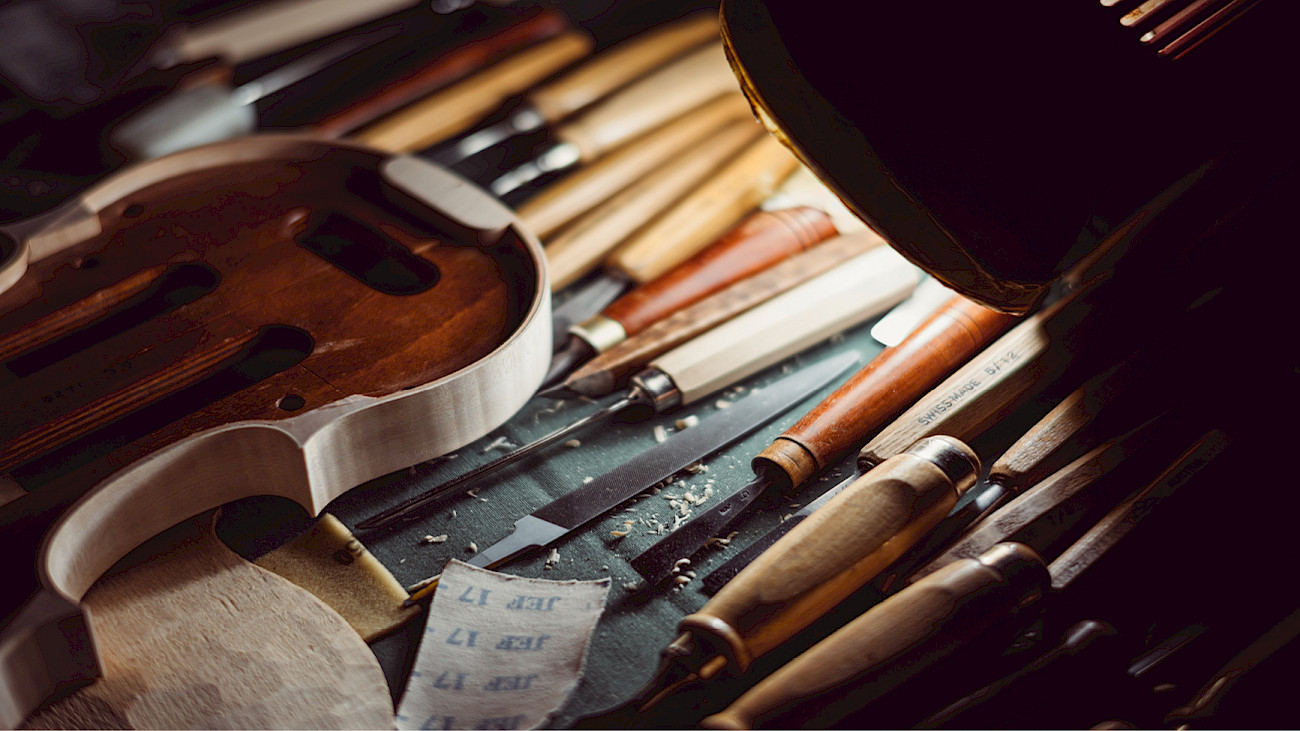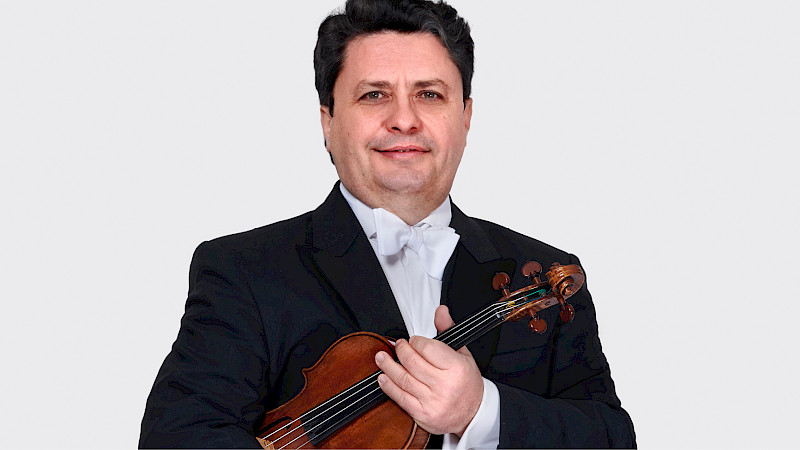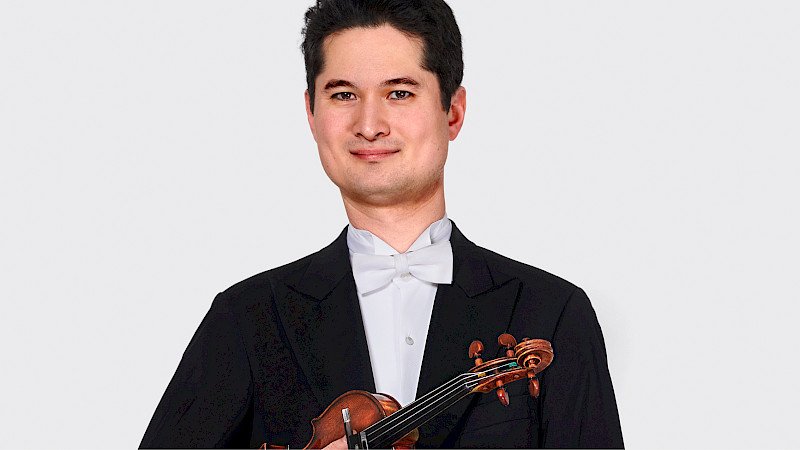
Stradivari's heirs
The history of the violin once began in the small northern Italian town of Cremona. Even today, almost everything here revolves around violin making. We visited two of the approximately 17O workshops.
"Welcome to what is probably the smallest workshop in Cremona," Katharina Abbühl greets us as she opens the glass door in Piazza della Pace in the centre of the city. And indeed, the room with the stylish vaulted roof is probably taller than it is wide. But the estimated 15 square metres are a world of their own: one that tells of a centuries-old craft - and of a fulfilled present. Wooden parts and tools lie on the worktable, and there are mouldings for the chisels and blades on the wall. Violin moulds and photos provide templates for the instruments, and the cut-outs of the last examples hang very decoratively on a "violin tree". In the centre of the room, "where it sounds best, by the way", a portable heater dispels the damp Cremonese winter chill.
Around six violins or violas are made here every year, without machines or semi-finished products. Around 80 individual parts per instrument are sawn, carved, planed, sanded, glued and varnished. And each individual work step requires patience and a profound knowledge of what you are doing. "You can't just do a little bit of violin making," says Katharina Abbühl, "your whole life is involved in this profession."
It is no coincidence that the Bernese violin maker, born in 1968, is living this life in Cremona. She first came here as a 19-year-old in search of a place to train, "and when I stood in the courtyard of the violin making school, I realised: this is where I want to learn". The course lasted four years, combining practical craftsmanship with technical, historical and musicological theory.
Katharina Abbühl's first job was in the repair workshops of the Jecklin instrument shop in Zurich, after which she returned to Cremona for further training, later spent a few years in Lucerne - and finally settled in Piazza della Pace eight years ago. You never know, she says, "but it could well be that I'll stay here". On the one hand, because she likes everyday life in Cremonese (and the coffee). And on the other hand, because nowhere else are the history and the living present of violin making so closely intertwined.
Amati, Guarneri, Stradivari
The story began in the 16th century, when violin maker Andrea Amati standardised the previously variable shapes and proportions of string instruments to such an extent that he is sometimes referred to as the "father" of the violin. His sons and grandsons continued to run the workshop, and other "liutai" joined them: The Guarneri family made their instruments in Cremona, which are still in demand today, and Antonio Stradivari and his sons also ran an extremely productive manufactory.
Why did Cremona become the centre of the "liuteria"? If you chug through the Po Valley on the local rumble train from Milan, you might wonder. But in Stradivari's day, the small town with its 50,000 inhabitants was a metropolis. Thanks to its location on the river, trade flourished and the wood for the instruments was also transported by water. And advanced craftsmanship was obviously important: the torrazzo of the magnificent cathedral is the tallest brick tower in Europe and the huge clock is a technical marvel from the Amati era.
The moulds
Templates are used to shape the body of an instrument. In the Cremonese tradition, these moulding boards provide the inner frame around which the ribs are bent. The back and top of the body are remodelled each time, so the corners, for example, can be shaped differently for each instrument. In French violin making, on the other hand, external moulds are used, so the body always looks the same - which facilitates a division of labour in production because the parts always fit together.
A jam jar on Katharina Abbühl's workbench shows just how much the location has influenced the development of violin making: it contains horsetails, "which used to be collected at the bottom of the river, as natural sandpaper, so to speak, which also leaves no grooves in the wood". Such details about the working methods of Stradivari & Co. are known thanks to recent research, "silica has been found under the varnish of instruments of the time, which could have come from horsetails". However, there is no direct tradition of the craft; the tradition that was once so important broke down astonishingly quickly and radically in the middle of the 18th century. With the death of Stradivari's sons and their successor Carlo Bergonzi, the heyday of Cremonese violin making came to an end and new centres were established elsewhere.
It is still a mystery today what led to this break. Katharina Abbühl suggests a social development: "The instruments of Stradivari or Guarneri del Gesù were luxury objects even back then. They were brought as gifts on state visits and entire court orchestras were equipped with them." But this demand was eventually met, and such instruments were far too expensive for "the people". As a result, production became cheaper and faster, "just like today" - so that the old Cremonese construction method fell into oblivion.
A new start in difficult times
It was only revived in the 20th century, in 1938 to be precise, thanks to a high-ranking and brutal fascist. His name was Roberto Farinacci and, in line with the fascist attitude, he wanted to promote the "national cultural heritage" - including violin making in his home town of Cremona. The violin making school was founded on his initiative, although it started at a rather poor level.
The turning point came in the 1950s: At that time, Simone Fernando Sacconi, a Roman violin maker and Stradivari researcher who had emigrated to the USA, travelled there to give masterclasses and his Milanese colleague Pietro Sgarabotto came to teach at the "Scuola Internazionale di Liuteria": they initiated what the "liutaio" Vincenzo Bissolotti, a few hundred metres away from Katharina Abbühl's workshop, calls a "rebirth".
Die Wölbung
Anders als bei Gitarren ist die Decke des Korpus bei Streichinstrumenten leicht gewölbt. Diese Wölbung wird sozusagen als Skulptur aus einem Brett herausgestochen: Es ist der heikelste Arbeitsschritt im Geigenbau, vieles muss stimmen, damit er gelingt. Schon zu Beginn gilt es aus Gründen der Stabilität darauf zu achten, dass die Jahrringe des Holzes senkrecht in der Wölbung stehen. Die Wölbung selbst wird dann mithilfe von Massstab und Höhenmesser ausgearbeitet.
A central figure in this "rebirth" was his father Francesco, who was originally a woodcarver but then switched to violin making. He was a pupil of Sgarabotto and Sacconi, later a teacher at the violin making school himself - and the father of four sons, all of whom became violin makers. Two of them are still active in the workshop in the quiet Piazza San Paolo: the aforementioned Vincenzo, who also worked as a teacher until his retirement a few years ago, and Marco Vinicio, who also represents the guild as a trade unionist and has documented the history of Cremonese violin making in several books.
Their workshop is much more spacious than Katharina Abbühl's. The entrance room is decorated with woodwork by her father, who has carved the path from tree to violin in relief. In the back room, a few violins hang on a leash, while jars and bottles of varnishes and resins are lined up in an apothecary's cupboard. In the space between them is the work table, a table lamp provides subdued light - and Vincenzo Bissolotti has to try out a few switches until he finds the one for the ceiling lighting to show us why he never switches it on: "You can't see anything if it's too bright, the structures of the wood are no longer recognisable."
He could go on for hours about which structures are ideal for violin making, how the growth rings should be organised, how to cut a trunk correctly and what to look out for when storing it. And the smell of the wood is also a topic, "we grew up under our father's workbench, so to speak, and played with the wood shavings, you never forget that smell". A spruce from the Val di Fiemme smells completely different to one from Lake Carezza, "that's no joke, my students once tested me with three different pieces of spruce and I localised them all correctly".
Violin making, as is also clear in the Bissolottis' workshop, is not just any job, "it's a love". It encompasses everything that goes with it - the history, the city, the music, the craft. It is a very intimate craft, says Vincenzo Bissolotti, a very personal one: "Although we all work with the same moulds, you can tell who made an instrument by the many details."
Listen and feel
But what is it that characterises this classical Cremonese school, which was added to the UNESCO list of intangible cultural heritage of humanity in 2012? For Katharina Abbühl, it's the holistic nature of the process, the slowness: "When the corpus is already finalised, it is acoustically checked and revised again, which is not done anywhere else." She only reveals how this works to her students. But it's not really possible to explain it so precisely, it's about discovering irregularities with your ears and hands - "it's fitting that 'sentire' means both 'hear' and 'feel' in Italian".
For Vincenzo and Marco Vinicio Bissolotti, it is also about the individuality of the instruments, "each one looks slightly different". The aim is not outright perfection, but personality: "An instrument doesn't have to please everyone, it has to please us first." Even with Guarneri del Gesú's violins, there are sometimes details that are not quite perfect, "but where it matters, he has invested an enormous amount of time". Not all "liutai" spend that much time any more, there are only a few left who build in the classic Cremonese style: perhaps twenty, estimates Vincenzo Bissolotti, "six or seven are here in the city, the rest are scattered around the world".
This means that Cremona is by no means only home to this style of building, but also many others. There are around 170 official workshops in the city, which with its 70,000 inhabitants is not much bigger today than it was in its heyday: a unique density of "liuterie" that is immediately noticeable when you walk through the streets and alleyways. Work is going on behind many windows, and the doorbells read not only Italian but also German, English and Japanese names.
How many of them benefit from the Cremona brand? How much folklore and nostalgia characterise this second wave of violin making? Of course there is chaff between the wheat, says Katharina Abbühl, "some violins look like sweets, all the same". But overall, the quality in different styles is high, and the scene is lively and genuine, "it's not just for show". People know each other, exchange ideas, "I go for coffee with someone almost every day". Although there is a lot of competition with so many workshops, "it's precisely because of this crowd that many musicians come here to test instruments". One then buys here, the other there, "all in all, it's good for everyone that we don't just have to deal with middlemen".
Occasionally, the "liutai" also get annoyed together, for example about the bureaucracy that makes it difficult for small workshops to take on apprentices. Or about the Cremonese city government's idea of categorising shavings as hazardous waste with the corresponding disposal fees. Marco Vinicio Bissolotti then defended himself as a trade unionist: "I told them that if anything, it was noble waste - natural wood, completely free of chemicals."
The lacquer
Is the secret of the Stradivarius in the varnish? Such speculations are made time and again, but the luthiers interviewed shake their heads in unison. There are no magical ingredients, says Marco Vinicio Bissolotti, "the old violin makers bought the same varnish that cabinet makers used back then". It was probably an oil-based varnish, the production of which would have been a fire hazard within the city. Katharina Abbühl and Ulrike Dederer also buy in their oil-based varnishes, while the Bissolotti brothers produce their own alcohol-based varnishes. The choice of varnish has little influence on the sound. More important is the primer, which involves several steps to close the pores of the wood so that the varnish does not sink in.
Concerts in the museum
Sometimes a group of "liutai" also sits around a table in the Museo del Violino, which also contributes a great deal to the cohesion of the scene. When a special instrument comes into the museum, they are invited for a presentation and expert discussions. Katharina Abbühl thinks this is a great offer: "We can hold the violins in our hands - only with gloves, but still". She also often visits the museum, "just to take a closer look at something, we have free entry".
That's exactly what Riccardo Angeloni wants. The 32-year-old Roman, who first trained as a violin maker in Cremona and then completed a master's degree in restoration and conservation of instruments, has been the curator at this museum since last year - and ensures that it is much more than just a museum. You meet him in the dark red-lined centrepiece of the exhibition, where he is just taking the Stradivarius "Vesuvio" from 1727 out of the display case. An "audizione" is about to take place, a short concert with a young violinist in the museum's own concert hall. Like every weekend, around 300 people have bought tickets, many tourists and a few locals.
The instruments are handled very carefully at these concerts, says Angeloni, "It is documented exactly how often they are played and there are clear rules for the musicians: No jewellery, never touch the violin by the body, don't walk around with it ". Not all of the museum's historical instruments are played in public. The Stradivari "Cremonese" from 1715, for example, is only played very rarely, "it is so well preserved that we want to keep it that way". But it is also checked several times a year: "If we notice that an instrument has changed in any way, we can intervene with restoration work."
he calls the principle "dynamic conservation": the aim is to protect the instruments, but in the knowledge that they don't really belong in a display case. Hence the short concerts, hence the invitations to violin makers. The museum is also active far beyond the exhibitions: in collaboration with the University of Pavia and Milan's Politecnico, it operates two laboratories, one for the non-invasive analysis of instruments, the other for acoustic issues. A new collection is being built up specifically for this purpose: In addition to the historical instruments and a collection from the mid-20th century, the winning instruments from the international "Antonio Stradivari" competition, which is held every three years, are exhibited here: "There is a growing body of documentation that will be exciting for future generations."
Three institutions
Casa Stradivari
The Amati, Guarneri and, for a time, Stradivari families of violin makers had their workshops in the same group of houses in the centre of Cremona. It was demolished in the 1930s and today the Galleria XXV Aprile, built in the Fascist style, stands on the site. However, another house has been preserved, in which Antonio Stradivari lived and worked after his marriage to Francesca Ferraboschi. It is located at Corso Garibaldi 57 and is run by the Fondazione Casa Stradivari, which was founded in 2021 under the direction of the Italian-Swiss violinist Fabrizio von Arx. As part of masterclasses, selected violin makers can build their own string quartet in the workshops on the ground floor for 18 months.
Museo del Violino
in 1894, the instrument dealer and collector Giovanni Battista Cerani donated part of his collection to the city of Cremona - this was the reason for founding the museum. Over time, further donations and purchases were made; for example, the violin maker Giuseppe Fiorini gave the museum significant parts of the collection of Conte Ignazio Alessandro Cozio di Salabue, who had bought numerous tools as well as instruments from Stradivari's last son and heir Paolo. The museum has been located in Piazza Marconi since 2013 and has its own concert hall, the Auditorium Giovanni Arvedi.
Scuola Internazionale die Liuteria
The violin making school is located in a historic building on Via Colletta 5 in the centre of Cremona. Further training opportunities are available in Mittenwald in Germany and in Brienz in the Bernese Oberland.
From Cremona to Zurich
One viola in this collection was made by violin maker Ulrike Dederer, who won the competition in 2012. She is a good friend of Katharina Abbühl, she was a student of Vincenzo Bissolotti - and has set up her own violin-making workshop in her garden in Zurich Oerlikon. The spruce wood box is about the same size as the studio in Piazza della Pace, and here, too, everything is made by hand: without prefabricated parts, without mechanical help; Ulrike Dederer only buys in the varnish, as the old Cremonese masters once did.
The moulds she uses as models for her instruments also come from them. And the wood usually comes from a tree that she bought years ago together with colleagues. It was in Trentino, the region where the historic Cremonese violin makers once sourced their materials. It's amazing, she says: "Things have developed enormously in all areas over the centuries. But in violin making, the models from the 17th century are still decisive."
Are these role models attainable? Yes, says Ulrike Dederer, "we have the knowledge and craftsmanship to make instruments today that are just as good as the old masters". It's not about copying; "even if I use the old mould boards - what I make from them is my instrument. It is my hand, my interpretation, my elaboration." The only thing missing from a new instrument is the myth. This is another reason why she learnt to play the violin so well as a cellist, so that she can try out her violins and violas, "they should really be ready when I show them to someone". After all, if a modern violin doesn't sound good straight away, it will probably be put aside more quickly than a Stradivarius.
However, this does not mean that the work is over when an instrument is sold - this is just as true in Oerlikon as it is in the Cremonese workshops of Katharina Abbühl and the Bissolotti brothers. Musicians often come back to their workshop months or years later to readjust details. And they are welcome: "It's interesting to see how an instrument develops."
Sometimes the decision is even made to make a major change, again in keeping with tradition: over the centuries, historical violins have been repeatedly adapted to new requirements. For example, Ulrike Dederer replaced the bridge on a viola after four years, "after that it was a completely different instrument". It belongs to violist Ursula Sarnthein - and together with two Stradivaris and a Bergonzi violin, it helps to ensure that the great Cremonese art of violin making continues to resonate in the Tonhalle-Orchester Zürich.
We use deepL.com for our translations into English.

























